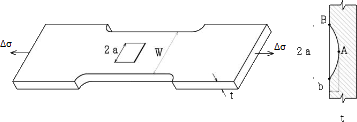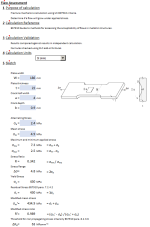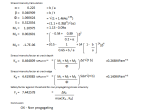Assessment of Flaw in Centre of a Plate in Tension

Description
Description
Flaw Assessment Overview
Objective of the Calculation
- Employing fracture mechanics principles, this calculation adheres to the UK BS7910 criteria.
- The aim is to ascertain whether a flaw will propagate given the applied stress.
Calculation Reference
- 'BS7910 Guide to methods for assessing the acceptability of flaws in metallic structures.'
Calculation Validation
- The outcomes have been cross-verified against results derived from an independent calculation.
- Formula validation was conducted utilizing the XLC add-in for Excel.
Units Employed in Calculation
- The calculation is adaptable to any unit system, noting that material properties may require conversion accordingly.
Additional Reference
- Fracture Mechanics
- 'BS7910 Guide to methods for assessing the acceptability of flaws in metallic structures.'
- 'API 579-1/ASME FFS-1 Fitness for Service'
The theory behind the calculation for the assessment of a flaw in the center of a plate under tension, particularly using the UK BS7910 criteria, revolves around Fracture Mechanics and Flaw Assessment. Here’s a summarized overview:
1. Fracture Mechanics:
- Stress Concentration: Flaws or cracks in a material create stress concentrations, which can lead to crack propagation and eventual failure under applied stresses.
- Stress Intensity Factor: This quantifies the stress distribution around the crack tip and is crucial in predicting the onset and rate of crack growth.
- Fracture Toughness: A material property that indicates its resistance to fracture, especially in the presence of a flaw or crack.
2. Flaw Assessment (BS7910):
- Flaw Identification: Recognizing and characterizing flaws in terms of their size, shape, and orientation within the material.
- Failure Assessment Diagram (FAD): BS7910 utilizes FAD, which is a graphical representation that combines the material's plastic collapse and fracture toughness properties to assess the significance of a detected flaw.
- Limit Load: The maximum load that a structure containing a flaw can sustain without undergoing plastic collapse.
- Fracture Assessment: Evaluating whether the applied stress and flaw size are within permissible limits defined by the material's fracture toughness.
3. Flaw Growth:
- Fatigue Crack Growth: Under cyclic loading, flaws can grow due to the stress concentration at the crack tip, which is analyzed using various models like the Paris Law.
- Critical Crack Size: Determining the size of the crack at which rapid, catastrophic fracture occurs, considering the applied stress and material properties.
4. Safety and Reliability:
- Safety Factor: Employing a safety factor to ensure that even with the presence of a flaw, the structure remains reliable under service conditions.
- Life Prediction: Estimating the number of load cycles that the structure can endure before the flaw grows to a critical size, leading to failure.
5. Material Properties:
- Elastic-Plastic Behavior: Understanding the material's behavior under applied loads, especially in the plastic deformation region, is crucial for assessing the flaw's impact on structural integrity.
6. Compliance with Standards:
- BS7910: Adhering to guidelines and methodologies outlined in standards like BS7910 for conducting comprehensive flaw assessments.
- API 579-1/ASME FFS-1: Sometimes, other standards might also be referred to, ensuring that the assessment is thorough and adheres to industry best practices.
In essence, the theory aims to evaluate whether a flaw within a plate under tension will propagate to a critical size under applied stresses, leading to structural failure, and to predict the remaining life of the structure. This is vital for ensuring safety and reliability in engineering applications, particularly in structures subjected to cyclic loads or operating in critical environments.
Calculation Preview
Full download access to any calculation is available to users with a paid or awarded subscription (XLC Pro).
Subscriptions are free to contributors to the site, alternatively they can be purchased.
Click here for information on subscriptions.


